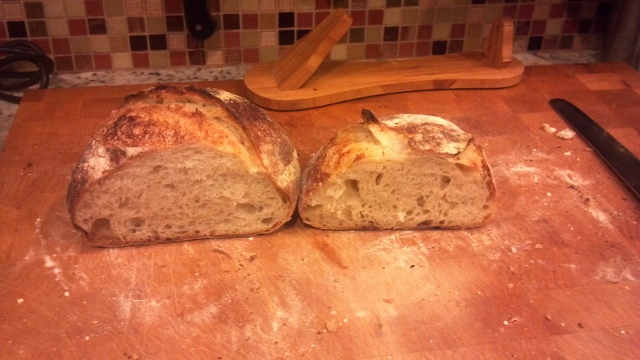
So, I've been keeping two starters for a while now - my own, started from scratch, and one made from rehydrated Carl's Oregon Trail starter. I recently reduced their hydration levels to 50%, and I'm really liking the way the stiffer starter works.
Anyway, they had both been languishing in the fridge for a while, so I decided to pull them out last night and give them a refresh. Then I thought "hey, why not bake a small loaf with each starter to compare their flavor and performance?" Fun, right? So, I let them both come up to room temperature, fed them, allowed them to double and then got started with my doughs. I made the same amount of a basic 75% hydration dough with both starters, and in both cases, the starter contained approximately 20% of the total flour in the recipe.
My homegrown starter (named Valentin) seemed a little more sluggish than the other (named Carlo) during the feeding process, but they both seemed ready when I mixed the dough. However, either I was wrong or Valentin is just REALLY slow, because after bulk ferment the dough made with Valentin was about half the volume of the one made with Carlo. I decided to press on and shape anyway, but again, Valentin really lagged. I baked Carlo first, so Valentin got an extra hour of proof time, but even so, you can see the difference in the pics (Carlo is on the left).
Luckily, the flavor of both breads is good, and I don't mind the chewier, heavier texture of the Valentin bread, but clearly I should have let that dough ferment/proof MUCH longer. That dough also didn't seem to have the strength of the other, despite the same amount of autolyse, folding, etc.
Anyway, does anyone have any suggestions as to how I can improve the performance of Valentin? Is it just a question of some more frequent feedings until he behaves as I wish? Or should I just accept that he's slow and deal with it?
Just refresh the sluggish starter a couple of times and you should be good to go.
Judging from the photo, the interior or both loaves looks similar. Were they weighed together and baked together? I had a recent experience where I forgot to steam a second loaf adequately, and it had perhaps 25% less oven spring than a properly handled dough from the same batch. Just a guess. I also agree with isand66. Repeated refreshing can really pep up a starter.
I agree that the interiors of the loaves look similar, but the texture was very, very different. The Valentin loaf was much denser and chewier, and I don't think it had to do with oven spring - that loaf rose less in the bulk ferment and MUCH less in the final proof. The two doughs were made separately (so as to preserve the integrity of the two starters) but were made with exactly the same amounts of the same ingredients. I didn't bake them together; the Valentin loaf was so under-risen when the Carlo loaf was ready to go in, I baked Carlo first, then let the dutch oven warm back up for a few minutes before putting in Valentin.
I find that the clock is not a good way to judge when the dough is ready for the oven. Let the dough "tell" you when it is ready. You can use the two finger indentation test. Gently press two fingers into the risen dough. If the indentation springs back, then the dough has not risen sufficiently. If the indentation is slow to recover, then the dough is ready. I suspect Valentin may be slower, so give it more time.
Ford
Oh, I know that watching the clock is a bad way to judge levain breads - this was just an experiment to see how the two starters behave, and I was surprised to find that one was so much faster than the other. I'm just wondering if Valentin needs to be refreshed more thoroughly before using him for baking, or if he might prefer to be maintained at a higher hydration level, etc.
Any reason to maintain both starters?
Not necessarily - I did this experiment in part to see if the two starters produced noticeably different flavors in the bread. They didn't, really, but I don't know if this was an entirely fair comparison given that one loaf was underproofed and therefore had a much different texture than the other. I'd really like to find a starter that delivers REALLY sour flavor and one that is milder, but I suspect that may have a lot more to do with feeding schedule/temperature than the strain of the starter itself. I may experiment with turning one of these into a rye starter too, to see if that gives me more sour oomph.
You can get a more sour flavor, by retarding the dough in the refrigerator for a day or more.
Ford
I've actually had limited luck with this - the retard gives me a fuller flavor but I wouldn't actually say it's more sour. I frequently do a 3-day retard on pizza dough and while the flavor is excellent, it's not particularly sour.
and you experience is why I do a 3 stage build to the required levain amount form a small amount of stiff starter. I want to make sure that the levain is ready to do its work and is at its peak before it ever hits the dough. Still, it you didn't have to throw it away and you can still enjoy eating ti - you have to call that a baking success. Get that sluggish starter back to full strength before refrigerating it again. You don't want th same thing happening next time.
Happy Baking
Yes, I think I need to try the three stage build going forward, especially with Valentin. The issue is timing - my pesky job interferes with my baking!